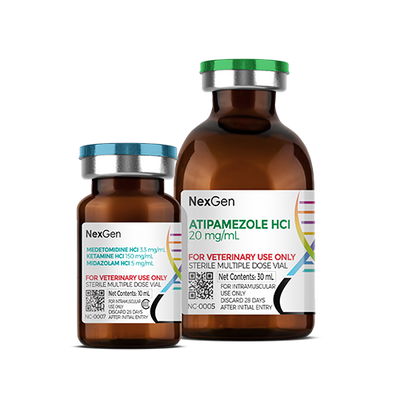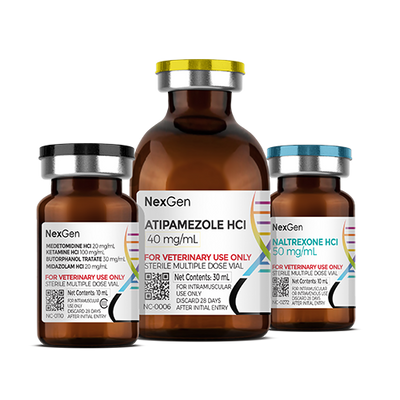
MKB™ Kit (Sedation & Reversal)
Login for pricing
- Brand
- Mixlab
- SKU:
- NC-0106K
- Product Type:
- Injectable
- Administration:
- Intramuscular
- Size:
- 10ml
- Controlled Substance:
- Schedule CIII
Butorphanol tartrate is a synthetically derived opioid agonist-antagonist analgesic of the phenanthrene series, with a potency of about four to seven times that of morphine. In combination with medetomidine HCL (10 MG/ML) and ketamine HCL (50 MG/ML), the three provide a safe and gentler induction and excellent recovery results.
By using the MKB™ kit from NexGen Pharmaceuticals, wildlife handlers are able to induce a reversible sedation, with inductions times ranging from 3 to 5 minutes and working times of 10 to15 minutes. The benefits of using these sedations is the ability for the animal to recover on its own if the handler does happen to lose the animal after darting it. MKB™ offers smooth induction with faster reversal times than regular MK due to the lower concentration of ketamine. The handler gets all the benefits of a traditional MK Kit (medetomidine/ketamine) knockdown, but with better reversal times.
The preferred route for the administration of an immobilizing drug by remote delivery is via intramuscular injection. The aim is to hit the animal in a specifically-selected site, causing injection into vascular tissue and facilitating rapid absorption of the drug. Not all areas of an animal's body are equally well-suited for injection by remote delivery; thus, the injection site should be carefully chosen.
The neck is generally a suitable site for large animals with muscular necks. Care should be taken to avoid hitting the jugular vein, the upper neck and the head. The ideal injection site is the trapezius muscle mass at the upper base of the neck. This injection site is suitable for species such as elk, moose, buffalo, bear, the equids and larger antelopes, rhinoceros, hippopotamus and elephant (if the ears can be avoided). Animals with slender necks, such as gazelle, gerenuk, giraffe and impala should not be darted in this area.
The shoulder is a suitable injection site in many larger species. This region is well-muscled, presenting a flat, perpendicular target. It is surrounded by relatively resilient areas and presents a fair-sized target in animals that are robust enough to be darted with remote delivery equipment.
To prevent the needle from becoming embedded in cartilage, the upper end of the scapula should be avoided. In sensitive species, the sight and smell of a dart in the shoulder may cause panic and flight. Some carnivores will destroy the dart by pulling it out with their teeth. The shoulder is not a suitable injection site for smaller species, due to their lesser size and limited muscle mass.
FOR RX ONLY: A valid prescription from a licensed veterinarian is required for dispensing this medication.




















